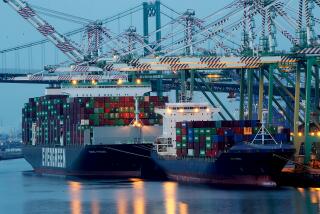U.S. Fishing Reel Maker Goes Offshore
TULSA, Okla. — Jimmy Houston, angler by trade, can tell you a story or two about the big ones that got away. But it’s the reel that got away that gets him down.
Houston can remember the first Zebco reel he saw. It was a Zebco 33 and built as solid as the 1950s into which it was born. And when his grandfather gave it a try, one cast sent the line singing all the way from the back door to the outhouse.
So easy to use, Americans bought into the Tulsa-made 33 hook, line and sinker for four decades. But those sales have slowed, and now Zebco is sending its production abroad.
“It’s pretty sad. This is probably the great American reel,” said Houston, who knew some of the workers who lost their jobs when Zebco closed its plant Feb. 2. “It’s almost like Chevrolets and baseball and apple pie.”
But Zebco isn’t the only U.S. manufacturer of note to ship out to a cheaper locale.
Converse Inc., the venerable sneaker maker, and Lionel LLC, whose model trains were long a fixture under Christmas trees across America, recently announced that they would close down U.S. plants in favor of Asian factories.
All three companies said the moves were a matter of making money or losing out to the competition. Most of their rivals made the move to cheaper Asian production years ago.
“I’d rather see Lionel continue to exist, even if it has to be made in Asia,” said Richard Maddox, president and chief operating officer of the Chesterfield Township, Mich.-based company, which announced on Feb. 1 the end of 100 years of U.S. production.
Lionel faced competitors who could offer similar products sometimes at half the price. The company can buy model trains from Asia for 40% less than it costs to make them itself in the United States, Maddox said.
“What we’ve attempted to do here is save an American icon that’s 100 years old and ensure it has another 100 years,” he said. “[Competition] gave us no choice but to go offshore.”
Converse’s announcement a week earlier that it would close three North American plants came as part of a bankruptcy reorganization. It was a decision the 93-year-old North Reading, Mass., company made reluctantly, said spokesman Mark Shuster.
‘We Hung in There Longer Than Anyone’
But its competitors, too, had already made the move and competitive pricing is even more important in the international market, where Converse now conducts the majority of its business, he said.
“We hung in there longer than anyone else,” Shuster said.
Zebco probably should have acted sooner than it did, said Jeff Pontius, the company’s president since 1998.
Most U.S. tackle manufacturers moved all but high-end reel production offshore decades ago. But it wasn’t until China emerged as a low-end reel power in the 1990s that the company found itself in trouble, Pontius said.
“We can’t buy the parts here for what it costs to get the entire product from there,” he said.
At the same time, fewer Americans were fishing. Single-parent families didn’t have time to load up the kids for a weekend trip. And when families did carve out the time, they tended to grab the cheapest equipment on the store shelf, and it wasn’t Zebco, said general counsel Don Freeman.
Zebco lost about 40% of the spin-cast reel market share between 1995 and 2000, Pontius said. Volume peaked at 7 million reels in 1995. Customers were telling the company “You guys better get with it,” he said.
About 300 people were making reels in Tulsa last year when Zebco and its parent, Brunswick Corp., made the decision to shift the work to China. Brunswick has since put Zebco up for sale.
Tears streamed down Shirley Schell’s cheeks as she described putting two children through college on the paychecks she earned at the plant, where researchers tested new products in a reflecting pool out front.
“It’s not only a sad day for me,” the 62-year-old said as she pieced together some of the company’s last U.S. reels last month. “It’s a sad day for this nation. You lose a 50-year-old company, an American-made product--everybody has lost.”
Even though its reels will now come from China, Zebco’s place in American angling history is secure.
The company started out as the Zero Hour Bomb Co., making explosives used in oil drilling. Its destiny changed in the late 1940s when a job-hunting West Texas watchmaker showed up and introduced the company to his invention--a fishing reel designed to prevent backlash, that messy tangling of line that comes with less-than-precise casting.
Suddenly, Anyone Could Fish
Little more than a tin can with two holes in it, R.D. Hull’s invention revolutionized fishing after Zebco introduced its version in 1949. Suddenly, anyone could learn to fish. By 1999, Zebco had sold 215 million reels.
“This thing was a boon to people. It made fishing so much easier,” said Ted Dzialo, executive director of the National Freshwater Fishing Hall of Fame in Hayward, Wis., where Hull is enshrined. “It rekindled interest in fishing.”
Houston, the angler and host of two outdoor shows on ESPN2, recalled how his Zebco 33 turned peaceful Oklahoma summers into pure terror for nearby perch, crappie and a particular 6-pound bass. Most angling professionals he knows started with a Zebco reel.
“Zebco will still be there,” he said. “It will just be different.”
More to Read
Inside the business of entertainment
The Wide Shot brings you news, analysis and insights on everything from streaming wars to production — and what it all means for the future.
You may occasionally receive promotional content from the Los Angeles Times.








